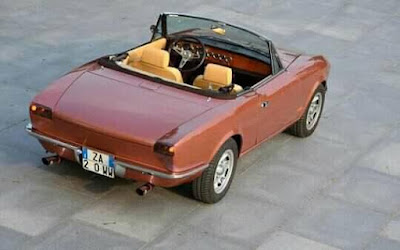Design Legacy - In the bustling cities of the world, including Indonesia, during the 1970s, certain cars became symbols of elegance and practicality. Among the most iconic were the Fiat 124 and Fiat 125, widely celebrated as mass-produced vehicles. Despite their broad appeal, these models also served as a canvas for imaginative transformations by esteemed Italian coachbuilders.
 |
| The 1964 Fiat 124 Rondine by Pininfarina. (Picture from: VeloceToday) |
These one-of-a-kind variants, crafted with exceptional attention to detail, took the original Fiat designs and transformed them into stunning works of art, reflecting the craftsmanship and vision of some of Italy's most prestigious automotive designers. This article will explore two notable examples of these special Fiat 124 and 125 variants, the Fiat 124 Rondine and Fiat 125 GTZ, and delve into their origins, design philosophies, and the lasting legacy they left in the automotive world.
1. Fiat 124 Rondine
The Fiat 124 Rondine, a prototype born from the collaboration between Fiat and Pininfarina, is a striking example of the creative experimentation that defined the mid-20th century Italian automotive scene. In 1964, under the direction of Sergio Pininfarina, American designer Tom Tjaarda was tasked with developing a unique version of the Fiat 124 Spider. Tjaarda, having gained attention for his work on the Chevrolet Corvette Rondine, was eager to create a vehicle that would merge the elegance of the Fiat 124 with the bold styling cues of the American Corvette. However, adapting these design elements to the smaller dimensions of the Fiat 124 posed a significant challenge.
 |
| The 1964 Fiat 124 Rondine by Pininfarina. (Picture from: Ocala Auto Repair on Facebook) |
Undeterred by these constraints, Tjaarda and his team meticulously crafted designs that showcased the dynamic features of the Chevrolet Rondine, including its aggressive front grille and distinctive rear profile. Despite their innovative approach, the project was ultimately halted by Sergio Pininfarina, who felt that the lavish design was too extravagant for a Fiat model, which needed to appeal to a broader, more cost-conscious market. The result was a pivot toward a simpler and more traditional design for the Fiat 124 Spider, which would go on to become a beloved and successful production car for over two decades.
 |
| The 1964 Fiat 124 Rondine by Pininfarina. (Picture from: Ocala Auto Repair on Facebook) |
Although the Fiat 124 Rondine prototype never reached mass production, its significance lies in its bold design direction and its role as a stepping stone in the evolution of the Fiat 124 Spider. Its unique color and design elements not only reflect Tjaarda's personal style but also mark an important moment in the history of automotive design, where creativity and functionality were pushed to new limits. While the Rondine may not have made it to the production line, its influence remains an important part of Fiat's legacy.
In contrast, the Fiat 125 GTZ is a direct manifestation of Italian automotive prowess, born out of the collaboration between two of Italy's finest coachbuilders, Zagato and OSI. Unveiled at the 1967 Turin Auto Show, the Fiat 125 GTZ was a striking departure from the standard Fiat 125 Berlina sedan. Built on a shortened wheelbase that was 24cm shorter than the original, the Fiat 125 GTZ exuded a sportier, more dynamic appeal, thanks to its transformation into a 2+2 configuration. The vehicle's bold yellow exterior and sleek lines immediately captured the attention of enthusiasts and designers alike.
 |
| The 1967 Fiat 125 GTZ by Zagato. (Picture from: Carrozzieri-Italiani) |
The design direction of the Fiat 125 GTZ was led by Ercole Spada, a designer known for his work on other high-performance Italian cars. The GTZ’s sportiness was accentuated not only by its sleek profile but also by the inclusion of roll bars, which enhanced the vehicle's safety and gave it a distinctive racing-inspired look. Under the hood, the Fiat 125 GTZ was powered by a 1.6-liter inline-four engine that produced 100 horsepower, delivering spirited performance that made it a joy to drive on both city streets and winding roads.
 |
| The 1967 Fiat 125 GTZ by Zagato. (Picture from: Carrozzieri-Italiani) |
While the Fiat 125 GTZ was originally intended as a one-off showcase model, its design and engineering represented the very best of Italian craftsmanship. The 125 GTZ was a symbol of how Italian coachbuilders could transform a mass-produced vehicle into something exceptional, blending style, performance, and innovation seamlessly. Its enduring appeal lies in its ability to capture the spirit of Italian automotive design—where form and function work in harmony to create a car that is as thrilling to look at as it is to drive.
 Both the Fiat 124 Rondine and the Fiat 125 GTZ highlight the creative ingenuity and passion that defined Italy’s role in the global automotive industry. These vehicles, though limited in production and scope, continue to captivate car enthusiasts and collectors around the world, representing an era of design that pushed boundaries and challenged conventional norms. Through their distinct designs and powerful legacies, they remind us that even mass-produced cars can hold within them the potential for extraordinary craftsmanship and innovation. *** [EKA | FROM VARIOUS SOURCES | CARROZZIERI-ITALIANI | STORY-CARS | OCALA AUTO REPAIR ON FACEBOOK | VELOCETODAY ]
Both the Fiat 124 Rondine and the Fiat 125 GTZ highlight the creative ingenuity and passion that defined Italy’s role in the global automotive industry. These vehicles, though limited in production and scope, continue to captivate car enthusiasts and collectors around the world, representing an era of design that pushed boundaries and challenged conventional norms. Through their distinct designs and powerful legacies, they remind us that even mass-produced cars can hold within them the potential for extraordinary craftsmanship and innovation. *** [EKA | FROM VARIOUS SOURCES | CARROZZIERI-ITALIANI | STORY-CARS | OCALA AUTO REPAIR ON FACEBOOK | VELOCETODAY ]Note: This blog can be accessed via your smart phone




 Logging you in...
Logging you in...